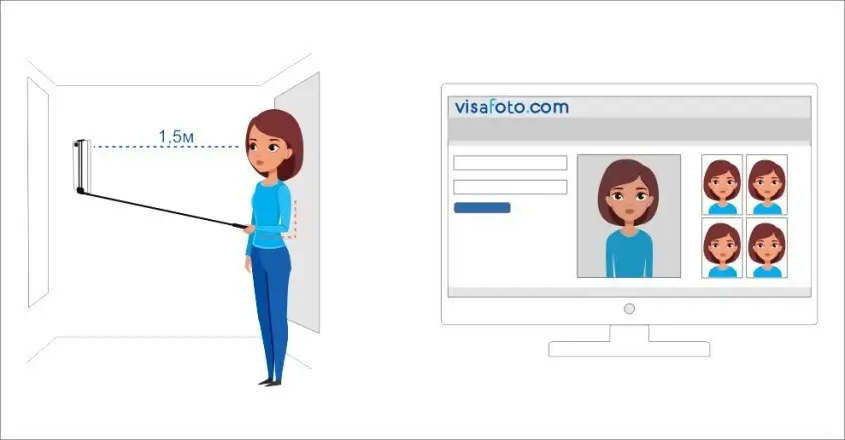India visa application for UK citizens: complete guide
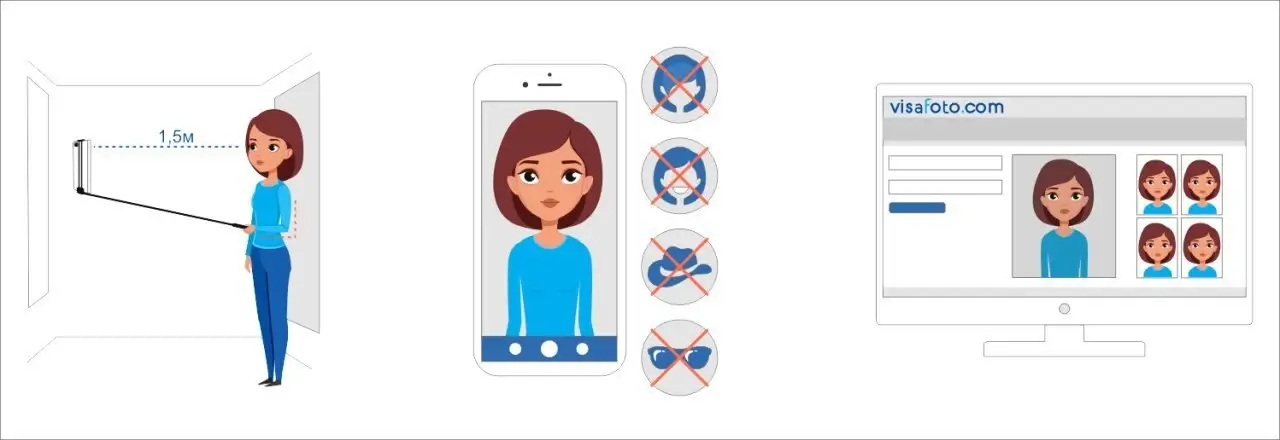
Whether you’re planning a short visit or a longer stay, UK nationals must secure the correct Indian visa before travelling. This article provides all the necessary information on Indian visas for British citizens, including details on required documents, fees, and where to obtain a compliant visa photo.
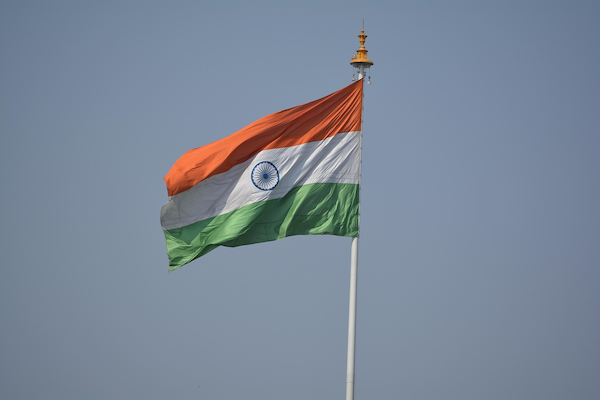
Table of contents
- Do UK passport holders need a visa for India?
- India visa options available for UK nationals
- India e-Visa requirements for British citizens
- How to apply for an India e-Visa from the UK
- India Regular Visa (sticker visa) for UK citizens: where and how to apply
- India visa photo requirements
- Get your India visa photo online
- Mobile visa photo maker
- India visa validity and prices for UK citizens
- How long does it take to get an Indian visa from the UK?
- Entry rules for UK citizens holding an Indian visa
- FAQ
Do UK passport holders need a visa for India?
UK citizens must hold a valid visa to enter India, whether they travel for tourism, business, medical treatment, or any other purpose. There is no visa on arrival for British passport holders travelling to India. For short tourist visits and business trips, it is possible to conveniently apply for an e-Visa online, without the need for a trip to the embassy. However, e-Visas are typically non-extendable and non-convertible, making them unsuitable for long-term work or study. Those activities require specific Regular (sticker) visas.
Can British citizens travel to India without a visa? No, unless they have a valid Overseas Citizen of India (OCI) card. OCI holders can travel to India visa-free, using their British passport and their OCI card.
India visa options available for UK nationals
UK travellers can choose between India’s streamlined e-Visa system and the traditional sticker visa issued through consulates. Here you’ll see how each option works and what purposes they cover.
Main e-Visa categories
- E-Tourist Visa, ideal for tourism, visiting family or friends, or taking short courses. It is generally available for 30 days, 1 year, or 5 years, with stays ranging from 90 to 180 days per visit, based on the visa type.
- E-Business Visa, suitable for business meetings, establishing contacts, or similar activities, typically offering multiple entries and up to 1 year of validity with limited stay periods.
- E-Medical and e-Medical Attendant Visas, designed for short-term medical treatments in India and for accompanying attendants.
- E-Conference Visa for attending conferences and workshops approved by the Indian authorities.
- Ayush e-Visa, intended for individuals seeking traditional wellness or medical treatments, like Ayurveda or yoga.
Regular (sticker) visa categories
If an e-Visa is unsuitable due to the purpose or duration of the stay, UK nationals need a regular “sticker” visa from the Indian mission or its designated visa centre. Common types include:
- Tourist and Business visas with longer validity or different stay limits than e-Visas.
- Employment visa for working in India, typically valid for up to 1 year or the length of the contract, and often extendable in India.
- Student visa for studying at an Indian institution, generally valid for the course duration, up to several years.
- Research, Intern, Journalist, and other specialised visas require specific documents and an in-person application with biometrics.
Long-term stay and special schemes
Individuals of Indian origin and their families might be eligible for a long-term Entry/“X” visa or Overseas Citizen of India (OCI) status, offering a multiple-entry lifetime visa eliminating the need for separate visit visas. UK citizens planning to live or work in India long-term often consider employment, business, student, or family-based visas, depending on their circumstances.
India e-Visa requirements for British citizens
India’s e-Visa has specific passport, document, and technical requirements that UK applicants must meet before applying. This part outlines the documents you need to prepare in advance.
To qualify for an e-Visa to India, British passport holders must have:
- A British passport that is valid for at least six months from the date of application and has at least two blank pages.
- A recent digital passport-style photo and a scan of the biographical page of their passport, which they must upload during the online application process.
- Depending on the category, additional documents may be required, such as a business card or employer letter (e-Business), hospital letter (e-Medical), or conference invitation and clearances (e-Conference).
- The traveller must also hold a return or onward ticket and sufficient funds for their stay.
How to apply for an India e-Visa from the UK
The e-Visa application is completed fully online, but it still requires accurate personal data, a compliant photo, and a clear passport scan. The process of applying for an Indian e-Visa for British citizens is outlined below:
- Visit the official Indian e-Visa website.
- Select “e-Visa Application” from the menu.
- Choose the appropriate e-Visa category, such as e-Tourist or e-Business, based on your travel needs.
- Complete the online form, providing personal details, passport information, and travel plans.
- Upload a scan of your passport's bio page and a recent passport-sized photo.
- Pay the visa fee using a credit/debit card or an electronic wallet.
- After submission, record your Application ID for status tracking. Use the “Check Your Visa Status” feature on the website to monitor your application's progress.
- Once approved, receive an Electronic Travel Authorisation (ETA) via email. Print the e-Visa and bring it when travelling to India. Present this printout at the immigration checkpoint in India for visa stamping.
India Regular Visa (sticker visa) for UK citizens: where and how to apply
Some UK travellers must apply for a traditional sticker visa, especially if they need long-term or specialised entry types. Here you’ll learn where applications are submitted and how the in-person process works for UK citizens.
According to the High Commission of India in London, UK, the Regular Visa service has been outsourced to Indian Visa Application Centres run by VFS Global in the UK. The Indian High Commission and its consulates in the UK do not accept Regular Visa applications directly by post or in person, except in some diplomatic or emergency cases.
To apply for an Indian sticker visa, follow these steps:
- Complete the online Regular Visa application form on the official Indian Visa Online portal. Print and sign the form.
- Book an appointment at the Visa Application Centre. Choose the nearest centre in the UK from the provided list.
- After booking, you will receive a confirmation email with your appointment details.
- Attend the appointment and submit your passport, application form, supporting documents, and visa fee.
- Track your application status on the VFS Global application status page.
- Collect your passport and visa from the centre or choose courier delivery if available.
India visa photo requirements
India applies strict standards to visa photos, and non-compliant images can delay or block your application. Below, we explain the exact size, background, quality, and composition rules UK applicants must follow.
- The printed photo should measure 2×2 inches (51×51 mm).
- For the e-Visa, use a square digital photo with at least 190×190 pixels in JPEG format. File size must range between 10 KB and 300 KB.
- Photos must be in colour with a plain white background, free of shadows and objects.
- Centre your head, capturing your full face from the top of the hair to the bottom of the chin.
- The head should occupy 1 to 1-3/8 inches (25 to 35 mm) of the frame, with the eye level between 1-1/8 and 1-3/8 inches from the chin.
- Maintain a neutral expression and look directly at the camera.
- Avoid harsh shadows or overexposed areas on your face.
- Wear solid-coloured clothes that are not white or patterned.
- If you wear glasses, ensure there’s no glare and that they do not cover your eyes. Tinted glasses are not allowed.
- Religious head coverings are acceptable, but your facial features from chin to forehead, and the edges of your face, must remain visible.
Here is a photo example:

Get your India visa photo online
Save time on your India visa by getting your photo done professionally online. Visafoto ensures your photo meets all requirements without visiting a studio.
Take a picture of yourself in natural light and upload it to Visafoto's tool below. We’ll adjust the format, background, size, and dimensions for you. Since 2013, Visafoto has met photo requirements for passports, visas, driving licences, and other documents worldwide.
Here is an example of the photo you can upload:
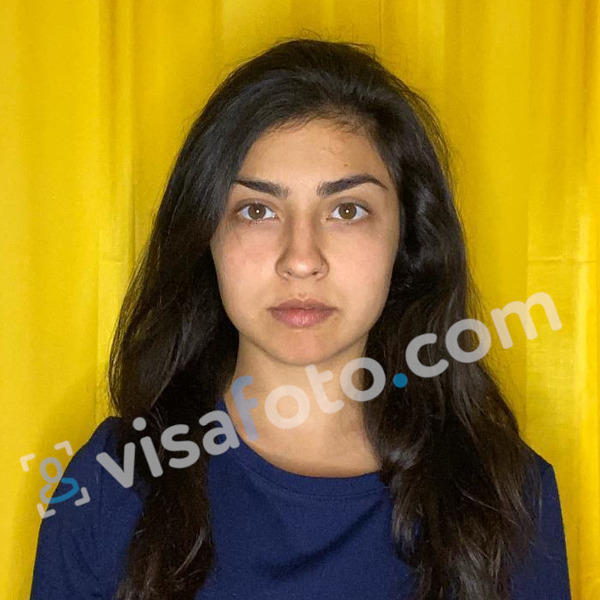
You'll receive both a digital version for online applications and a print-ready file. If you're not satisfied, we offer a free replacement. If officials reject the photo, we will provide a full refund.
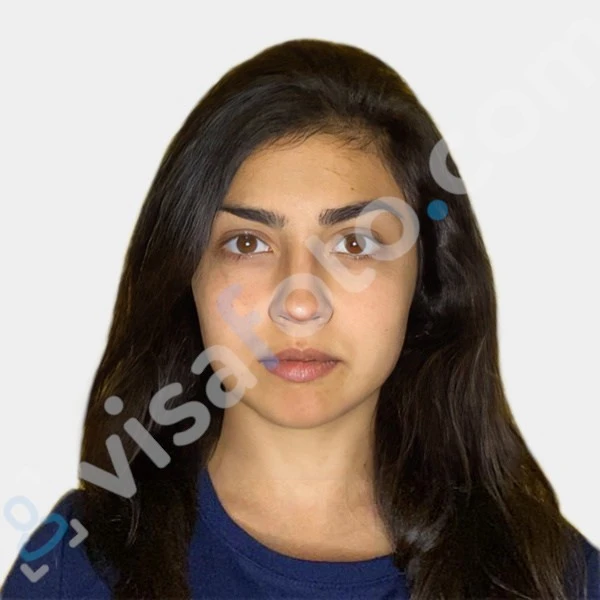
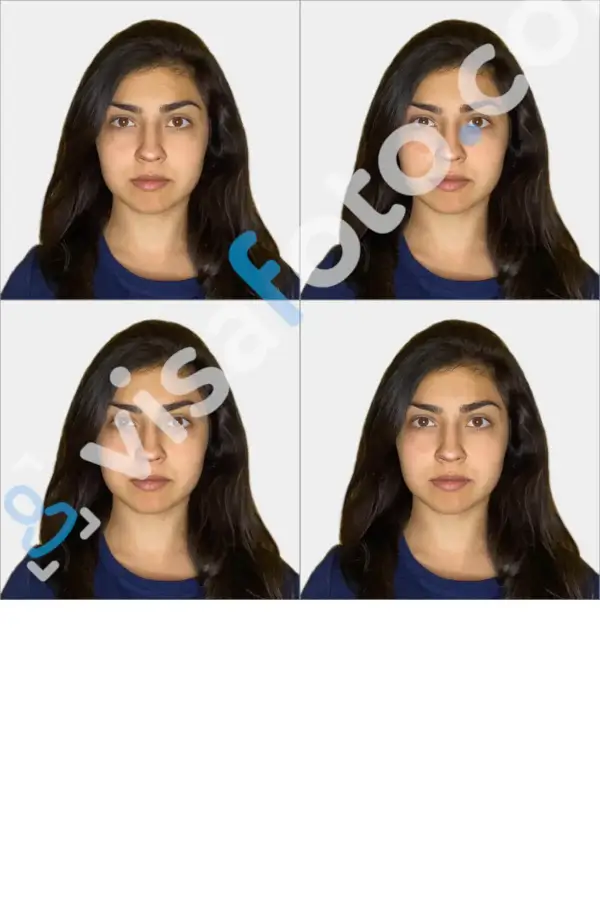
Mobile visa photo maker


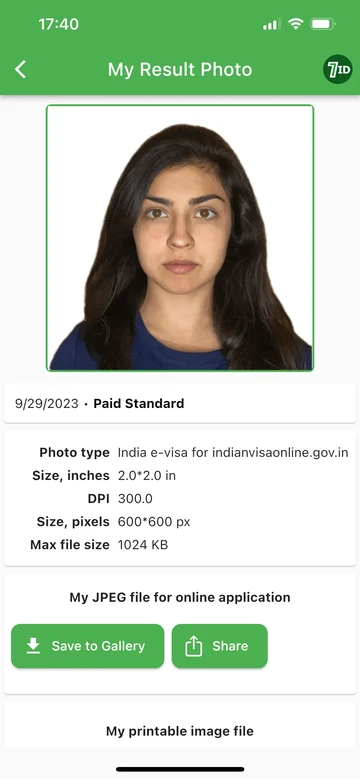
Use the 7ID app from Visafoto.com to create visa photos directly from your phone. Designed for ease, this app works on both iPhone and Android devices.
Upload your photo to the 7ID App, select India and visa as your document type, and the app will automatically adjust your photo to meet official specifications, including size, format, and background colour. Your face and eyes will be perfectly centred. You’ll receive a digital file for online submission and a print template compatible with 4×6, A4, A5, or B5 paper sizes.
Our technical support team is available 24/7 to assist with any questions.
India visa validity and prices for UK citizens
Visa fees and validity periods vary by visa type, trip purpose, and chosen processing method. This part summarises the current options available to UK citizens so you can budget accurately and choose the most suitable visa.
UK citizens can choose from three types of e-Tourist Visas for India: 30 days (double entry), 1 year (multiple entry), and 5 years (multiple entry).
How much is a Tourist visa to India for UK citizens? The cost of a 30-day e-Tourist visa to India from the UK is USD 25 (approx. GBP 19) between July and March, and drops to USD 10 (around GBP 8) from April to June. The cost of a 1-year e-Tourist visa to India from the UK is USD 40 (about GBP 30.5).
How much is a 5-year e-Visa to India from the UK? The 5-year e-Tourist visa costs USD 80 (about GBP 61).
All visa fees are subject to an additional 2.5% bank charge.
How much is a 5-year Regular Visa to India from the UK? For one to five years (multiple entry), it costs GBP 378. For up to one year, the cost is GBP 127 for single or multiple entries.
How long does it take to get an Indian visa from the UK?
The processing times for UK citizens applying for an Indian visa online or in person vary, and can also change during peak travel seasons. Below, you’ll find processing times for each option:
- The e-Visa typically takes 3 to 5 working days. Some applications may be approved within 24 to 78 hours. To ensure timely processing, apply at least 4 to 5 days before travelling.
- Regular (sticker) visas processed through Indian Visa Application Centres (VFS Global) in the UK generally take 7 to 15 working days. Times may vary based on the visa type and administrative load.
Entry rules for UK citizens holding an Indian visa
Holding a visa does not guarantee entry, and Indian border officers follow specific rules when checking arriving UK travellers. This part outlines the essential regulations that UK citizens entering India on a visa must adhere to.
- Ensure the visa type aligns with the purpose of your visit, whether for tourism, business, or medical reasons. An Overseas Citizen of India (OCI) cardholder is exempt from needing a visa.
- Have a machine-readable British passport with at least 6-months-validity from the arrival date in India, and ensure it has at least 2 blank pages for immigration stamps.
- Complete an online e-Arrival card prior to reaching Indian immigration to record arrival details digitally.
- E-Visa holders must enter through designated airports or seaports. For the current list of permitted checkpoints, click on the “Authorised immigration checkpoints through which e-Visa holders can travel” section on the e-Visa portal.
- Ensure your visa details match your passport exactly to avoid entry refusal or deportation.
- Undergo biometric verification (fingerprints and photograph) upon arrival with an e-Visa.
- If staying beyond 180 days or required by your visa type, register with the Foreigners Regional Registration Office (FRRO) within 14 days.
- Carry a Yellow Fever vaccination certificate if arriving from a country where it is endemic, and potentially a polio vaccination depending on your travel history.
- Provide evidence of onward or return travel plans and sufficient funds to satisfy immigration regulations.
FAQ
How far in advance can I apply for an Indian visa?
UK citizens can apply for an India e-Visa up to 120 days (around 4 months) before their trip, for e-Tourist visas lasting 1 or 5 years. For the 30-day e-Tourist visa, apply no more than 30 days before arrival, with a minimum processing time of 4 days. While there is no specific earliest time to apply for regular (sticker) visas, it is best to apply several weeks to a few months in advance.
Do I need a transit visa for a stopover in India?
If you remain in the airport's transit area during a stopover, you don't need a transit visa. However, if you need to exit the airport or have a longer layover, you must get a transit or appropriate visa in advance. The transit visa allows up to 3 days in India and must be used within 15 days after issuance.
Can an Indian e-Visa be extended?
Generally, Indian e-Visas cannot be extended beyond their initial validity. These e-Visas allow multiple entries for up to 1 or 5 years, but single visits must not exceed 90 days (or 180 days for certain categories). For a longer stay, apply for a Regular Visa at an Indian consulate or embassy. While extensions for e-Visas are rare, you may request one through a Foreigners Regional Registration Office (FRRO) or Foreigners Registration Office (FRO) under exceptional circumstances.
How long can I stay in India on a tourist visa?
UK citizens can stay in India for up to 180 days within one calendar year on a tourist visa, including e-Tourist visas. Each continuous visit typically cannot exceed 90 days.
Is the India e-Visa available for British passports that are not biometric?
Yes, India e-Visas are available for all British passports, whether biometric or not. The passport must be valid for at least six months from your arrival date in India and have at least two blank pages.
What should I do if I’ve made a mistake on my e-Visa application?
If you make a mistake on your India e-Visa application, you typically cannot edit it online after submission. For critical errors like a wrong name, passport number, or date of birth, you'll need to submit a new application. Contact the Indian e-Visa support desk immediately by email or phone if you notice an error post-submission. They might cancel your original application to let you reapply correctly, especially if you bought reapply protection through a service. Otherwise, submit a new application as soon as possible with accurate details.
Am I allowed to enter India through a different airport than the one I listed on my application?
India e-Visa holders can enter only through the designated international airports listed by the Indian government. Ensure the airport on your application is one of the officially approved entry points, listed on an Indian e-Visa portal under the “Authorised Immigration checkposts through which eVisa holders can travel” section. For departure, travellers with an e-Visa may exit from any authorised immigration check post, even if different from their entry point.
